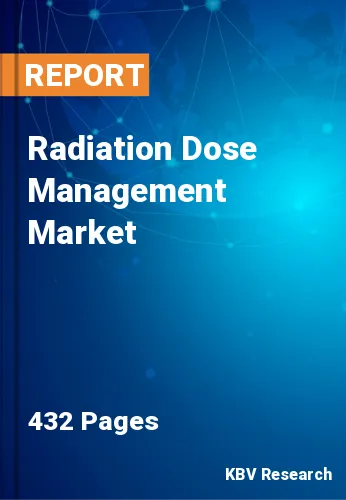
The Global Radiation Dose Management Market size is expected to reach $858.1 million by 2030, rising at a market growth of 14.6% CAGR during the forecast period.
Mammography is a crucial tool for breast cancer screening, which is a common practice for early detection and diagnosis. As the importance of regular mammographic screening grows, there is an increased focus on managing radiation doses to ensure that the benefits of screening are maximized while minimizing potential risks. Consequently, the mammography segment would generate approximately 16.38% share of the market by 2030. The demand for effective dose management solutions arises from balancing mammography's diagnostic accuracy with the imperative to keep radiation doses as low as reasonably achievable.
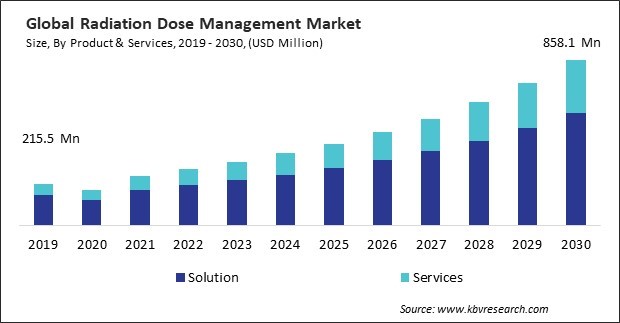
The major strategies followed by the market participants are Product Launches as the key developmental strategy to keep pace with the changing demands of end users. For instance, In November 2023, Canon Medical Systems, a subsidiary of Canon, Inc., has broadened its CT portfolio with the launch of two new scanners: the flagship system, Aquilion ONE/INSIGHT Edition, and the high-throughput system, Aquilion Serve SP. The Aquilion ONE system simplifies high-quality scanning, making it more efficient. Meanwhile, the Aquilion Serve SP enhances clinical confidence for all routine examinations, including trauma and cardiac procedures. Additionally, the Aquilion Serve SP features an 80-cm wide-bore gantry with two easy-to-use touch screens and built-in cameras that support automated one-touch patient positioning. In July 2022, Siemens Healthineers AG has launched Mobilett Impact 1, a mobile X-ray system. Mobilett Impact is an X-ray system used for imaging patients at their bedside, enabling imaging workflow to be carried out right where the patient is. Additionally, the mobile system is designed to provide an optimal radiation dose, addressing one of the biggest challenges in healthcare.
Based on the Analysis presented in the KBV Cardinal matrix; Bayer AG is the forerunner in the Market. In June, 2022, Bayer AG unveiled Calantic Digital Solutions, a platform delivering access to digital applications, including AI-enabled programs for medical imaging. Calantic Digital Solutions is a set of digital tools for radiology that use AI to help radiologists and their teams at important stages during a patient's treatment process. And Companies such as GE HealthCare Technologies, Inc., Siemens Healthineers AG, and Canon, Inc. are some of the key innovators in Market.
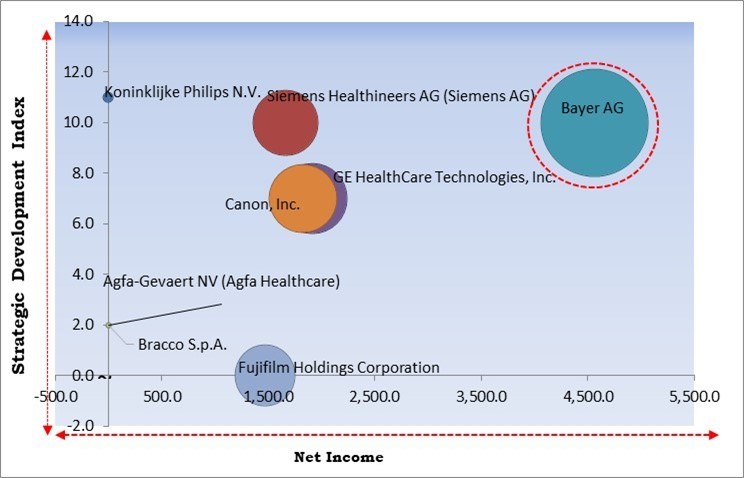
The pandemic led to changes in imaging patterns, with decreased routine medical imaging procedures and increased imaging related to COVID-19 diagnosis and monitoring. These shifts in imaging priorities influenced the demand for radiation dose management solutions differently across various imaging modalities. Many healthcare facilities were compelled to delay or postpone non-urgent projects, including implementing new technologies. Thus, the COVID-19 pandemic had a negative impact on the radiation dose management market.
Medical imaging is essential for both diagnostic and therapeutic purposes. Advancements in imaging technologies, such as X-rays, computed tomography (CT), magnetic resonance imaging (MRI), and nuclear medicine, have expanded the range of applications, leading to a higher frequency of imaging studies. The rising prevalence of chronic diseases, such as cardiovascular diseases, cancer, and musculoskeletal disorders, contributes to the increased demand for medical imaging. Diagnostic imaging plays a crucial role in the early detection, diagnosis, and monitoring of these conditions. Hence, the increasing use of medical imaging procedures is driving the growth of the market. Moreover, Heightened awareness of the potential health risks associated with ionizing radiation exposure has increased the focus on patient safety. Healthcare providers and patients alike are more conscious of the need to minimize radiation doses while maintaining diagnostic accuracy. Therefore, the growing concerns about radiation exposure are propelling the growth of the market.
Implementing radiation dose management systems often involves significant upfront capital expenses. Healthcare facilities must invest in software licenses, hardware infrastructure, and possibly new equipment or upgrades to existing systems to integrate dose management capabilities. Integrating radiation dose management solutions with existing healthcare information systems, such as electronic health records (EHRs) and picture archiving and communication systems (PACS), can be complex and costly. Thus, the cost of implementation is hampering the growth of the market.
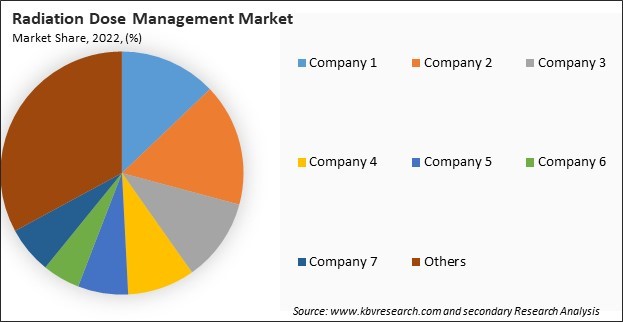
The leading players in the market are competing with diverse innovative offerings to remain competitive in the market. The above illustration shows the percentage of revenue shared by some of the leading companies in the market. The leading players of the market are adopting various strategies in order to cater demand coming from the different industries. The key developmental strategies in the market are Product Launches and Product Expansions.
 Drivers
Drivers  Restraints
Restraints  Opportunities
Opportunities  Challenges
Challenges Based on end-user, the market is categorized into hospitals & healthcare system, ambulatory surgery centers, diagnostic & imaging center, and others. In 2022, the hospitals and healthcare system segment registered the highest revenue share in the market. Hospitals are increasingly prioritizing patient safety and the delivery of high-quality care. Radiation dose management solutions enable healthcare providers to monitor and control radiation exposure during diagnostic and interventional procedures, ensuring patient safety remains paramount. Effective radiation dose management helps healthcare providers mitigate risks associated with excessive radiation exposure, reducing potential liabilities and enhancing overall patient care outcomes.
On the basis of modality, the market is categorized into computed tomography, fluoroscopy & interventional imaging, radiography, mammography, and nuclear medicine. The radiography segment witnessed a considerable revenue share in the market in 2022. Radiography, which includes X-ray imaging, is one of the most commonly used medical imaging modalities. It is employed for various diagnostic purposes, including imaging of bones, joints, chest, and soft tissues. The widespread use of radiography contributes to this segment's growing demand for effective dose management solutions. Radiography, an ionizing radiation modality, requires careful management to ensure that diagnostic benefits are achieved with the lowest possible radiation dose. Dose management solutions play a crucial role in addressing these patient safety concerns.
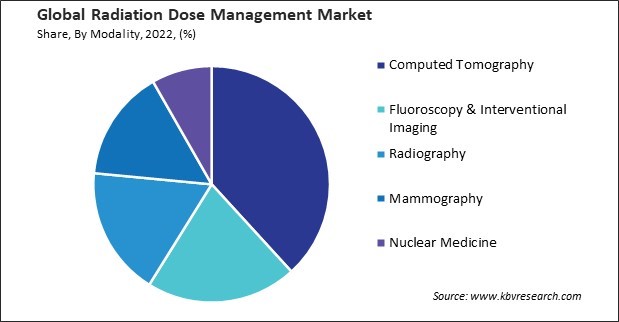
On the basis of application, the market is segmented into oncology, cardiology, dental, orthopaedic application, and others. The oncology segment recorded the largest revenue share in the market in 2022. Advances in radiation therapy, such as intensity-modulated radiation therapy (IMRT), stereotactic body radiation therapy (SBRT), and proton therapy, have made it possible to deliver more precise and targeted doses of radiation to tumors while minimizing damage to surrounding healthy tissue. Furthermore, regulatory requirements and guidelines related to radiation therapy are also driving the demand for RDM solutions in oncology.
Based on products & services, the market is bifurcated into solutions and services. In 2022, the solution segment garnered the highest revenue share in the market. Healthcare providers increasingly recognize the importance of implementing comprehensive dose management solutions to optimize radiation exposure in medical imaging procedures. The growing awareness of potential risks associated with ionizing radiation and stringent regulatory requirements have fueled the need for advanced tools and technologies.
The solution segment is further subdivided into standalone solutions and integrated solutions. In 2022, the standalone solutions segment attained the largest revenue share in the market. Standalone solutions are often modular and scalable, allowing healthcare providers to implement specific components based on their immediate needs. This flexibility is beneficial for facilities that may not be ready to invest in a comprehensive, integrated system but want to address specific challenges related to radiation dose management.
By mode of deployment, the market is segmented into on-premises, cloud, and web-based. The cloud segment procured a remarkable revenue share in the market in 2022. Cloud-based solutions are scalable, allowing healthcare providers to adapt their radiation dose management tools based on changing needs. This scalability is particularly important in the dynamic healthcare environment where imaging volumes and data storage requirements vary. Furthermore, cloud-based tools provide healthcare professionals remote access to radiation dose data and management tools. This accessibility is crucial for healthcare providers who need to monitor and manage dose information from different locations or when working remotely.
Free Valuable Insights: Global Radiation Dose Management Market size to reach USD 858.1 Million by 2030
Region-wise, the market is analyzed across North America, Europe, Asia Pacific, and LAMEA. In 2022, the Asia Pacific region generated a substantial revenue share in the market. The Asia Pacific region is witnessing significant investments in healthcare infrastructure development. As new healthcare facilities and imaging centers emerge, there is a growing need for radiation dose management solutions to ensure the safe and efficient use of medical imaging technologies. The increasing prevalence of chronic diseases in Asia requires frequent diagnostic imaging procedures. Radiation dose management becomes crucial in managing the cumulative radiation exposure for patients undergoing multiple imaging studies.
| Report Attribute | Details |
|---|---|
| Market size value in 2022 | USD 294.9 Million |
| Market size forecast in 2030 | USD 858.1 Million |
| Base Year | 2022 |
| Historical Period | 2019 to 2021 |
| Forecast Period | 2023 to 2030 |
| Revenue Growth Rate | CAGR of 14.6% from 2023 to 2030 |
| Number of Pages | 432 |
| Number of Tables | 653 |
| Report coverage | Market Trends, Revenue Estimation and Forecast, Segmentation Analysis, Regional and Country Breakdown, Competitive Landscape, Market Share Analysis, Porter’s 5 Forces Analysis, Company Profiling, Companies Strategic Developments, SWOT Analysis, Winning Imperatives |
| Segments covered | Product & Services, Mode of Deployment, Modality, Application, End-User, Region |
| Country scope |
|
| Companies Included | GE HealthCare Technologies, Inc., Bayer AG, Koninklijke Philips N.V., Siemens Healthineers AG (Siemens AG), Fujifilm Holdings Corporation, Canon, Inc., Bracco S.p.A., Novarad Enterprise Healthcare Solutions, INFINITT Healthcare Co. Ltd., Agfa-Gevaert NV (Agfa Healthcare) |
By Product & Services
By Mode of Deployment
By End-User
By Modality
By Application
By Geography
This Market size is expected to reach $858.1 million by 2030.
Increasing use of medical imaging procedures are driving the Market in coming years, however, High cost of implementation restraints the growth of the Market.
GE HealthCare Technologies, Inc., Bayer AG, Koninklijke Philips N.V., Siemens Healthineers AG (Siemens AG), Fujifilm Holdings Corporation, Canon, Inc., Bracco S.p.A., Novarad Enterprise Healthcare Solutions, INFINITT Healthcare Co. Ltd., Agfa-Gevaert NV (Agfa Healthcare)
The expected CAGR of this Market is 14.6% from 2023 to 2030.
The Computed Tomography segment is leading the Market by Modality in 2022 there by, achieving a market value of $311.2 Million by 2030.
The North America region dominated the Market by Region in 2022 there by, achieving a market value of $323.3 Million by 2030, growing at a CAGR of 13.9 % during the forecast period.
Our team of dedicated experts can provide you with attractive expansion opportunities for your business.
